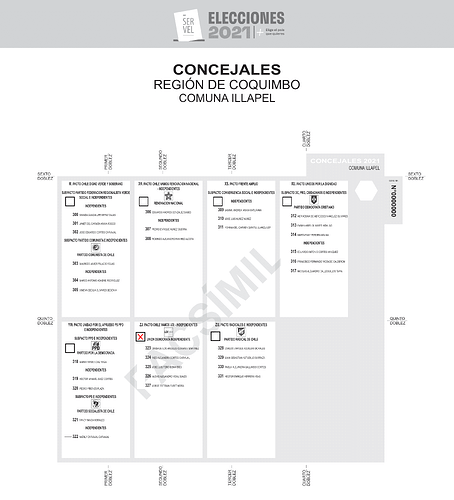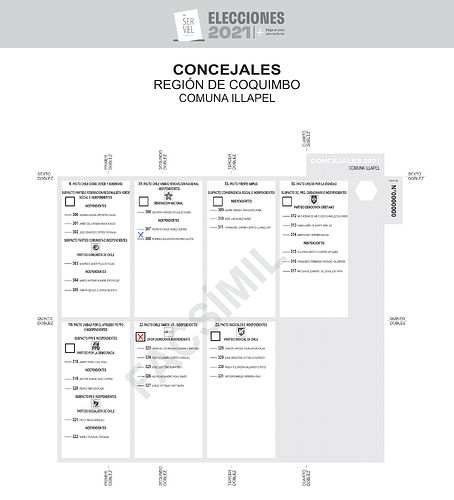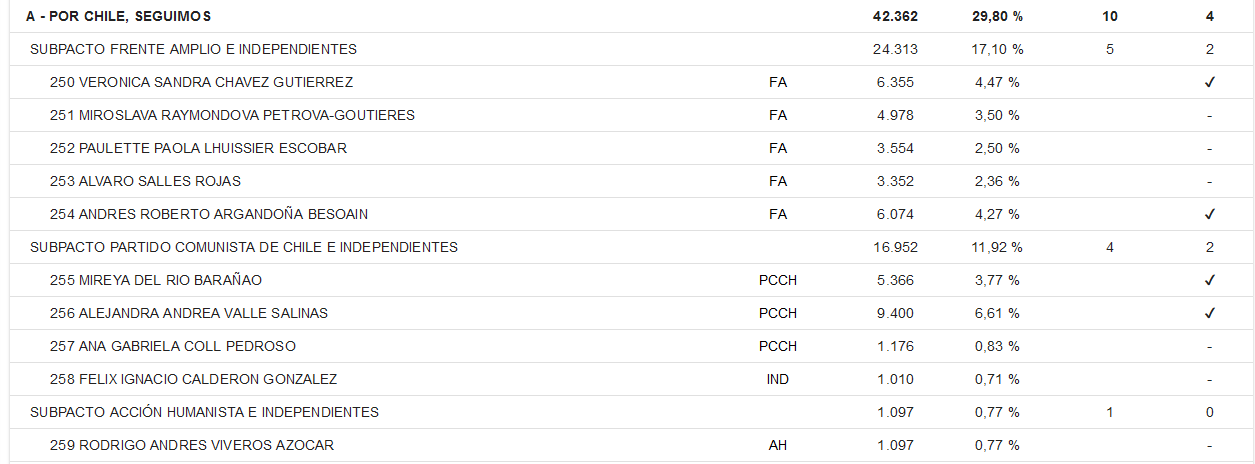Last year, I made this post looking for guidance on how regional and municipal legislative seats are allocated based on vote share.
I’ve had a follow-up investigation for the benefit of future voters on my todo list for some time now and, given that the congressional elections are coming up fast, I finally sat down to document this for anyone interested.
A SERVEL page kindly provided by @gringalais in that previous thread did not provide much illumination on the system because it only talks about lists, not the candidates on the lists themselves.
Before the municipal elections last year, I tried to divine secrets from this 2011 municipal ballot paper, but alas.
So, after voting in the 2014 municipal elections, I decided to try to use the RESULTS of the election to try and deduce how what is captured on the ballot translates to seats in the legislature.
NOTE: I am making the assumption that the same system is used for diputados as is used for consejeros and concejales so what I say here should be applicable for the forthcoming elections.
Herewith, my comments:
The task is to allocate 10 seats based on 142174 valid votes cast.
-
The first thing to note is that there is one lista per pacto/subpacto, so that is the grouping mechanism to take into consideration when rolling up votes.
-
It appears that the pacto/subpacto listas are presented to SERVEL in order of preference as is normal in list-based electoral systems. The idea is NORMALLY that a political party will win a number of seats, and then the electoral body will allocate those seats based on the rank order of candidates submitted by the party. So, if we look at the ballot for concejales in Coquimbo in 2011, for example, what would NORMALLY happen is that you would only vote for the pacto/subpacto as a WHOLE (the candidates might appear on the ballot for information purposes but you couldn’t specify a specific preference). The ballot would simply look like this:
Note that the vote is cast against the pacto not the candidate.
Let’s say that Pacto Chile Vamos UDI- INDEPENDIENTES won 20% of the vote in such a scenario. They would win 2 out of 10 seats, and candidates 323 and 324 would be sent to the legislature. This is how a purely proportional representation system works.
- The problem with pure proportionality is that voters cannot hold individuals directly accountable as they do in constituency-based, “winner take all” systems, as is the case in the US and UK. To remedy this, one can implement mixed member proportionality (MMP) which blends constituency-based systems and proportional systems. This is accomplished by allocating a portion of the seats to be directly elected. You effectively have a purely proportional election for one portion of the seats and a different election for the constituency-based seats. The relative proportions are set by legislation, but you would have TWO separate ballots to accomplish this, one with party lists where you vote for the party, and one where you vote for a candidate WITHIN A party OR an independent. And I emphasise ‘A’ party because you may very well choose to vote for an individual candidate that is not party of the party you support, like an independent, for example, or even not at all. IMPORTANTLY, you can choose not to vote directly for a candidate if direct accountability does not concern you.
An explanation per ChatGPT:
In Mixed-Member Proportional (MMP) electoral systems, voters typically cast two votes on one ballot (or sometimes two separate ballots), and candidate information is formatted to clearly separate constituency candidates from party lists.
 Typical MMP Ballot Format
Typical MMP Ballot Format
 1. Constituency Vote (Candidate Vote)
1. Constituency Vote (Candidate Vote)
- Voters select one candidate to represent their local electoral district (like in First-Past-the-Post).
- Candidates are listed by name, with their party affiliation (or “Independent”).
- Voters mark one box next to their chosen candidate.
 2. Party Vote (List Vote)
2. Party Vote (List Vote)
- Voters select a political party — this determines the overall proportional makeup of the legislature.
- Parties are listed by name, often with a party logo.
- Sometimes, the top list candidates are also shown next to each party name.
- Sometimes, the top list candidates are also shown next to each party name.
 Example Layout (Single Ballot Format)
Example Layout (Single Ballot Format)
------------------------------
🧍 Constituency Vote (Choose 1)
[ ] John Smith – Party A
[ ] Mary Jones – Party B
[ ] Alex Lee – Independent
🧾 Party Vote (Choose 1)
[ ] Party A – (Smith, Patel, Gomez)
[ ] Party B – (Jones, Kim, Singh)
[ ] Party C – (Doe, Ali, Müller)
------------------------------
In some systems (like New Zealand or Germany), the ballot is split into two sections on the same sheet, but both votes are cast together.
 Design Considerations:
Design Considerations:
- The candidate list is by local district, while the party list is national or regional.
- Parties may field a constituency candidate and a party list simultaneously.
- Voters can split their vote: vote for a candidate from one party and give their party vote to another.
 Summary:
Summary:
MMP ballots separate constituency candidates (individuals) and party list options (for proportional seats). Candidates are listed with names and parties, while party votes show the parties and sometimes their top list nominees.
- The thing is that, as is its wont, Chile refuses to do things logically, and so, the ballots for legislature seats (i.e. diputados, consejeros and consejales) make the attempt to incorporate the accountability of individual candidates within the scope of a purely proportional system, and it attempts to do so by combining the two votes of an MMP system into one. The idea is that a direct vote for a candidate translates into a vote for a party. The problem, however, is that if you don’t give a shit about direct accountability (and most people DON’T) you now no longer have the ability to vote for the pacto/subpacto without voting for a specific candidate. If I want to support the lista for a particular pacto/subpacto, and let the pacto/subpacto decide who gets sent to the legislature, there’s no way I can indicate that IDGAF.
If they HAD to have ONE ballot, it COULD look like this:
But note that this would STILL be a BAD design for MMP because the formatting doesn’t do a good enough job of indicating that two separate elections are happening.
Better yet, two ballots, one with only pactos/subpactos and the other with only candidates. This would almost completely eliminate confusion.
Notice now that under an MMP system, I can vote for the pacto, and they can choose a candidate for me, and, if I so choose, I can ALSO vote for another candidate to compete in the constituency-based seat which gives me direct accountability (maybe I’ve seen that guy working particularly hard at service delivery in my area).
But, let’s take a look at how it ACTUALLY works based on the Ñuñoa results for 2024.
Let’s look at Pacto I / Chile Vamos Renovacion Nacional - Independientes
- The pacto as a whole won 21.21% of the vote which wins them 2 seats for allocation. Candidates 283 and 284 are the first two candidates on the pacto list and they got 7.54% and 7.93% of the votes respectively and so they are sent to the legislature. Something bothered me about this, though, because candidate 283, which was the pacto’s first choice candidate got the second most votes after candidate 284. This got me wondering what would happen if there was another candidate further down the list than the number of seats the pacto won (if that makes sense), and I found such an example.
- In the case of Pacto A / Subpacto Frente Amplio e Independientes, the subpacto won 17.10% of the vote which equates to 2 seats; however, the 2 seats allocated were for the subpacto’s first choice, 250, which won the most votes in the subpacto, and the fifth choice candidate which won the second most. Thus, the system does give the voter a degree of accountability by overriding the subpacto’s preferred list; HOWEVER, this comes at the cost of clarity because, the fact of the matter is that the majority of people don’t care about direct accountability and only want to vote for their party. Therefore, what is bound to happen is that the majority of people are just going to choose the first candidate who appears on their list which unfairly boosts that candidate within their subpacto. Candidates lower down in the party list therefore have to work harder to win the necessary votes. There are also theoretical absurdities whereby a pacto has, say five candidates, competing for 10 seats, the pacto wins 30% of the votes, gets 3 seats, but when you look at the breakdown of support, the first candidate won 30% of the vote, and the other four none, but two still go to the legislature on the back of the first candidate’s “effort”, which I guess is fine but it still feels icky, and ickiness would be resolved using a proper MMP system.
Conclusion
Anyway, what this boils down to is that, fortunately, vote-splitting between candidates within a pacto or subpacto is not a risk under this system, which was the main concern I had when I first raised it last year. Close your eyes and vote for whichever candidate your pen lands on within your pacto. Or just vote for the first one if you’re lazy. It doesn’t really make a difference unless you REALLY care about holding a particular candidate to account (and even then it’s not a fair system to the candidates).
That said, it is, as we would say in South Africa, kak, and if Chile really wants to have a proper electoral system, it needs to either use purely proportional representation (sub-optimal) or implement a proper MMP system (the gold standard) like a big boy.
I hope this helps anyone trying to understand how to vote for representatives in Chile.





